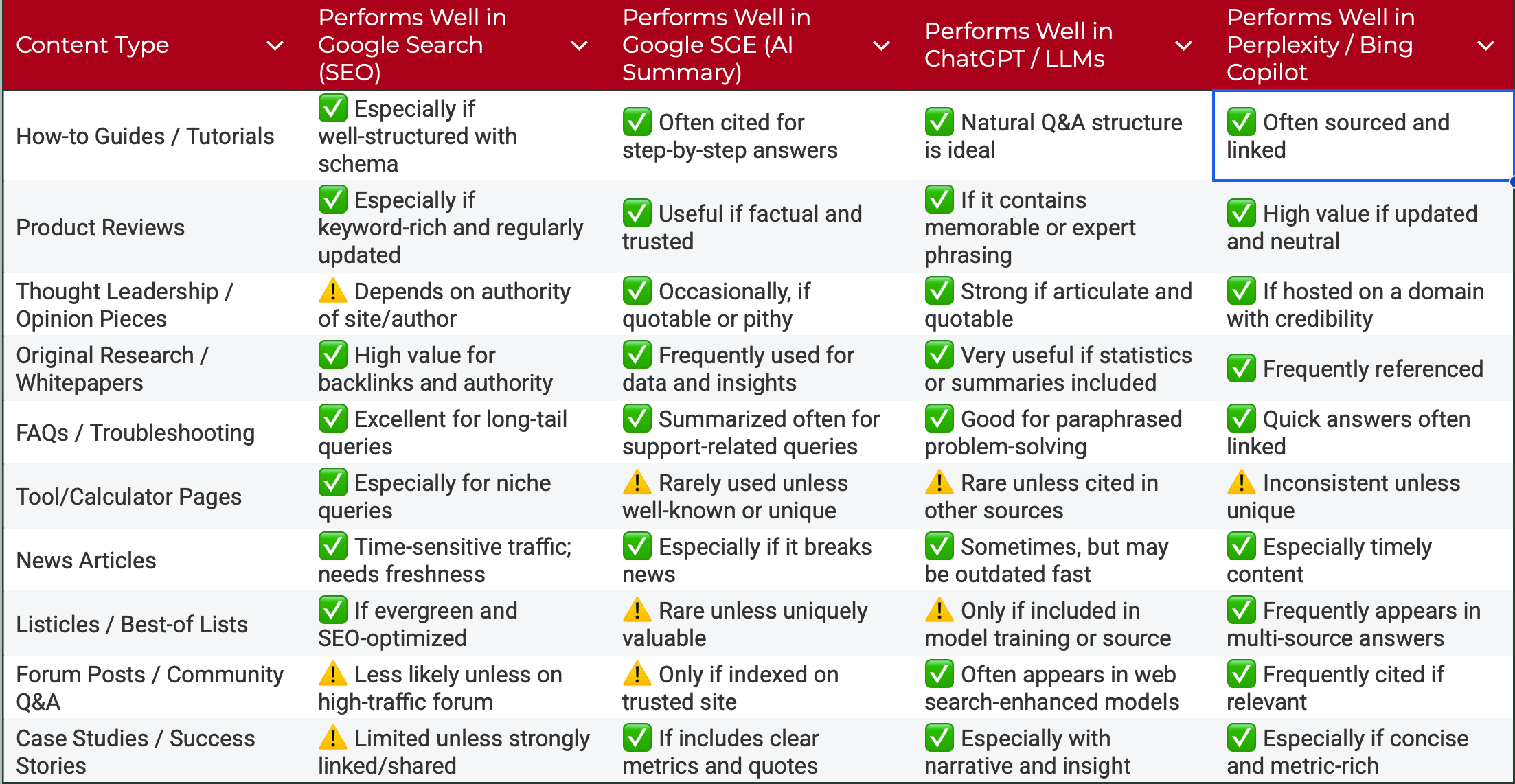In a sister article , we looked at how to make your website work for real people, in the age of AI. The TL;DR for that original article is: AI is shaking up traditional web search, especially for those of us that aim to perform in the long tail. With AI both summarising (Google SGE) and synthesising (ChatGPT) answers, there’s a new story emerging for search optimisation. One take away that applies to all platforms is that the value of creating content designed solely to rank is eroding, while the value of content that adds true depth or authority is rising. Which brings us neatly to the subject of this follow-up article: How to get your content seen by real people and AI.
Look for that win-win-win
At Cohesive, we create brand stories, content strategy and lots of content. That’s why we have skin in this game. If you’re like us, then you don’t have time to continually stay ahead of the intricacies of search ranking algorithms, LLM preferences and what not. What really helps people like us is a set of ground rules to make our content as valuable to artificial readers as flesh and blood ones – with the emphasis firmly on that last group.
There is some positive news here off the bat. If you are the kind of author primarily driven by a passion for what you do, an expert in your subject, an instinctive untangler of complexity and intricacies for a curious readership – then keep doing what you’re doing. Your best instincts are pretty close to best practice.
"If you only take one thing away from this article, make it this. Write for real people, who are as smart, interested and articulate as you are."
That’s especially true for LLMs like ChatGPT, which thrives on conversational tone, natural question-and-answer structures, good context, genuine depth and insight, and original or colourful metaphors, analogies and examples. What it likes, your readership should love.
A bit about Semantic SEO
What we’re loosely talking about above is technically called Semantic SEO. So now you know. It’s been quite a while since search engines focused on just keywords in content. Traditional Google Search can evaluate a complete topic – including context, intent, themes and related themes, key words and synonyms. Think about the shift in scope from, say, ‘Home made yoghurt recipe’ to ‘Why you should make yoghurt yourself, and how to do it’.
As Gen AI meets more and more of the search demand, its extra cognitive horsepower and preference for natural, conversational language multiplies the relevance of Semantic SEO. And as we said above, it’s pretty straightforward to understand, for people who instinctively create valuable content. Every kind of AI-powered search wants to answer real questions, not just robotically parrot phrases that match questions like some language school comprehension test.
TL;DR | Design your content to explore a topic deeply, answer the question fully, cover related questions and contextual connections.
The rest is about structure and format.
Add Vitamin S | Semantic SEO for Content Creators
You’ll want the mega-dose. Here’s how to do that.
- Write with a real person in mind, their actual needs and careabouts. And in every case, consider them to be as clever, articulate and curious as you are.
- Embrace the whole topic – in our yoghurt example, certainly write the ‘how-to’, but also
- Reasons you might want to
- When you can’t wait… | When time is your friend…
- How, and how long, to keep it
- Anticipate and answer the follow-up questions
- Lactose intolerance and yoghurt
- Dairy fats – what you need to know
- Gut microbiome benefits
- Link to related articles you’ve already published
- Recipes that include yoghurt
- Best equipment for beginners to invest in
- Use natural language, and avoid keyword/key phrase stuffing
Can AI-Search detect AI-generated content?
Specifically, no. But it can tell weak content from strong. Original from me-too. And LLMs like added colour in metaphors, quotes etc. So, just keep creating strong content. Our advice is, use AI as a research assistant and an editing sounding board. Always create the first draft yourself – no better way to straighten out your thinking. The colour, and the final draft, is for you to do. You are the maker!
You’re aim is to be included and mentioned
AI Search like Google SGE aggregates and interprets information from the web, curating a summarised answer that includes some citations. LLMs including ChatGPT create synthesised answers – generating new content from existing data – and often but not always include mentions or citations too.
We’re going to shoot for the stars here, even if that might feel a bit daunting. Aim to have your content included in the AI-generated answer and get you mentioned as the source ( cited, linked-to, footnotes ).
Why? Because – unlike actual space travel – the energy and complexity is about the same for a moonshot as interstellar travel, in the universe of search. So aim high because it’ll cost you no extra – if you’re doing it organically, that is.
Which brings us to a salient point. You can still buy the authority and ranking to boost yourself into the AI summary in Google SGE (as well as other search engines that rely on ad revenue). Probably, meaningful boosts are beyond the reach of you and us, except in very targeted, niched subjects. And you can’t bribe ChatGPT – at least not yet.
So back to organic. Semantic SEO is your strategy to be ranked and included, and it boosts your chances of a mention too. That’s because you’re offering genuine value to a model that aims to provide the most complete answers. As there’s only so much room in an AI-generated answer, a mention is an expedient way to direct a committed searcher to the full answer.
How else can you incentivise AI-search to not just include you, but mention you too?
How to maximise your chances of being mentioned organically
- High strength Vitamin S – Semantic SEO. Make it your one-a-day.
- Include a clear by-line, and link to, or include, an author bio.
- Structure your content to be easily summarised and parseable. Chunk your copy up and imagine each ‘chunk’ as an answer to a particular reader question. Always within the context of telling the story you need to tell, that is
- Use clear headlines, sub heads, and schema hygienes – these still matter for traditional search. There is some nuance though*
Then there is the stuff that can’t easily be synthesised or included within an AI-answer – so could merit a mention:
- Creative, powerful metaphors that simplify or amplify human understanding
- Original, attributed quotations, clearly pulled out in the copy
- Diagrams, flowcharts, and original artwork
TL;DR | If you want to be named in the AI era, write like you believe you are worth quoting.
* The nuance of structure and schema *
We all understand the basics of structure and schema in the context of the traditional web search engine. We use key words in heads and subheads, because those engines are looking to match the symbols their users are typing. Hidden schema tags (added by your usual SEO plugin) help the machine better interpret what it’s looking at. And a nuanced headline can simply confuse the poor thing.
LLMs like ChatGPT read and interpret headlines differently. Not as formulaic ‘signals’ but more like a human reader would – with a capacity to look beyond the symbols to see the words and their meaning. You can argue that LLMs reward, rather than penalise, creativity. We asked ChatGPT what it preferred!
“Write headlines like you would for an intelligent curious reader.” – ChatGPT
Probably, it’s a case of horses for courses. If you’re writing a How-to keep all your headlines to the point, and you’re pleasing every kind of reader. If instead you’re writing for an audience that needs to be entertained, can be trusted to make up their own minds, your arguments have intriguing shades of grey, etc, try writing the <h1> like you would for traditional Google search, and the <h2> to capture ( and captivate) the LLM (and human) reader.
How different content performs in different models
Not only do different search and AI platforms read your content differently, they value it differently too. Use that knowledge to calculate the mix of content to produce. A meta-analysis – and yes, we used AI – from a lot of sources got us to a summary of the content likes and dislikes of traditional Google Search, Google SGE (AI summaries), alongside ChatGPT, Bing/Co-Pilot and Perplexity (all LLM – powered, with chat interfaces).

Cohesive’s bread and butter is original storytelling and expert long-form content. The stuff that caught our eye is:
- How to Guides | Seem to perform everywhere (with some nuance on structure as discussed above
- Though Leadership | Looks to us like the LLMs are the place to optimise for. Vitamin S all the way.
- Original research | In an AI-dense web, original insight is increasingly rare. Trad Google is going to rank your research by signals like citations and backlinks – publication on high ranking platforms, references from peer articles and journals (which is a posh, academic way to say ‘community’) and so on. Original, niche research has a better track record than most for achieving those things. As well, the LLMs are going to evaluate it for themselves and likely to value genuine insight really highly.
- FAQs | Keep them evergreen
- Calculators and listicles | Click-bait bites the dust, on everything other than trad Google
- Forums, Pods, Newsletters | Basically, anywhere where you can share your expertise and depth with a niche, committed community. LLM-powered search is your friend and, other things equal, an opportunity to punch above your weight.
Finally – Bollocks to the algorithm
Maybe you screamed your own version of this long before we got to this point. We’re with you. While you shouldn’t ignore them, it’s more important than ever to figure out your own ways to bypass the algorithms and deliver your content directly, whenever and however you can.
Your own mail newsletters. Your own podcasts. Good old fashioned publishing. The traditional media sector has taken a pummeling, but there are still outlets where you don’t need to pay to play, and the more niche and original you are, the more likely you are to find an outlet. And, piggyback on someone else’s pod, and get face-to-face as a guest in someone else’s themed event. Start where you are. Use what you have. Do what you can. And then do it some more.





What do you think?